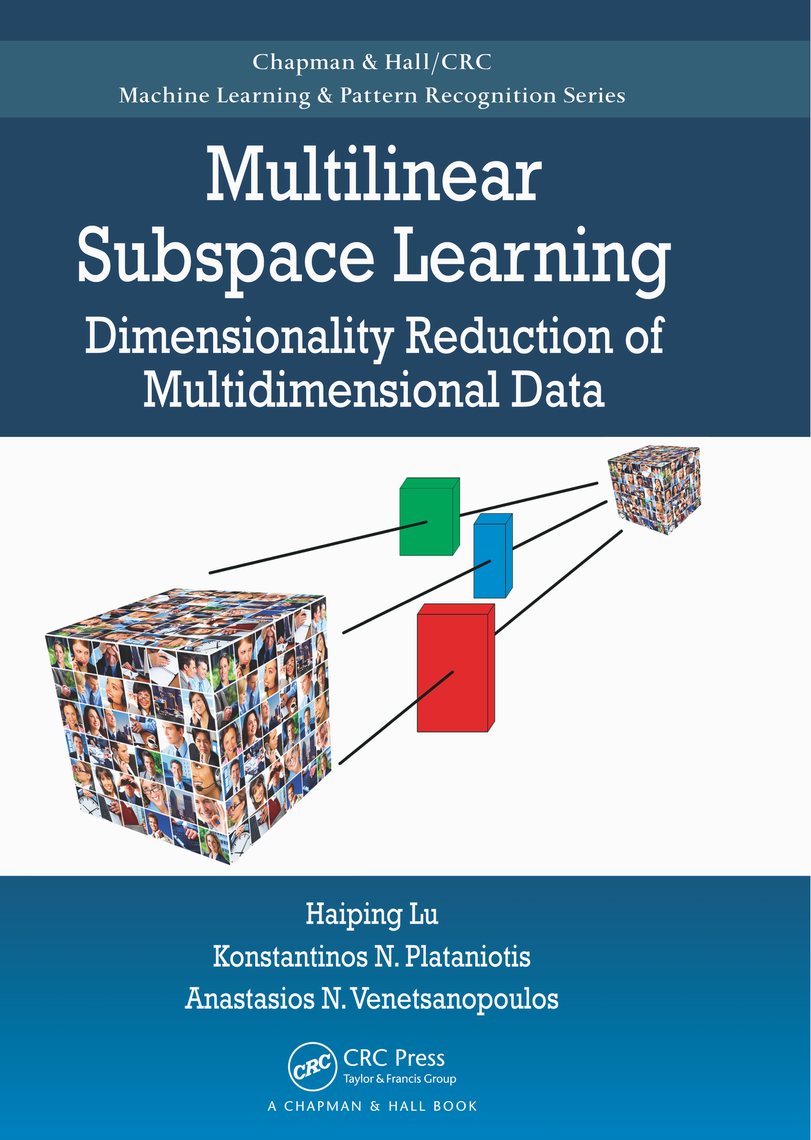 Multilinear Subspace Learning
Multilinear Subspace Learning Multilinear Subspace Learning
Multilinear Subspace LearningThis web site aims to provide an overview of resources concerned with theories and applications of multilinear subspace learning (MSL). The origin of MSL traces back to multi-way analysis in the 1960s and they have been studied extensively in face and gait recognition. With more connections revealed and analogies drawn between multilinear algorithms and their linear counterparts, MSL has become an exciting area to explore for applications involving large-scale multidimensional (tensorial) data as well as a challenging problem for machine learning researchers to tackle.
| [ Book/Survey | Software | data | Related Sites | Research Papers ] |
Multilinear Subspace Learning: Dimensionality Reduction of Multidimensional Data,
Haiping Lu,
K. N. Plataniotis, and
A. N. Venetsanopoulos, Chapman &
Hall/CRC Press Machine Learning and Pattern Recognition Series, Taylor
and Francis, ISBN: 978-1-4398572-4-3, December 2013.
Order:
Amazon.com,
Amazon.ca,
Amazon.co.uk,
Amazon.fr,
Amazon.de,
Amazon.co.jp,
亚马逊中国,
CRC Press (Save 20%);
Contents: Table of
Contents;
Preview
Sample Chapters:
Chapter 1,
Chapter 3;
Review:
Recommed at computingreviews.com (Review
Link; PDF);
Errata/Corrections:
Errata - 19 Jan 2015, Corrections -15 Feb 2014;
Software:
Open Source Software;
Data:
2D face data & 3D gait data.
A Survey of Multilinear Subspace Learning for Tensor Data, Haiping Lu, K. N. Plataniotis, and A. Venetsanopoulos, Pattern Recognition, Vol. 44, No. 7, pp. 1540-1551, Jul. 2011.
Open source software on multilinear subspace learning algorithms:
The FERET face data [2-D tensor (matrix)] and training/test partitions:
C=number of subjects;A=max angle;S: number of samples/subject
C70A15S8 (3.09M);
C80A45S6 (893K);
C160A45S6 (1.32M);
C240A45S6 (1.68M);
C320A45S6 (2.04M).
The CMU PIE face data [2-D tensor (matrix)] and training/test partitions: PIEP3I3 (10.2M).
The USF gait data version 1.7 [3-D tensor]: 128x88x20 (21.2M); 64x44x20 (9.9M); 32x22x10 (3.2M).
Wikipedia entry on Multilinear Subspace Learning.
Papers relevant to MSL are ordered below according to topic, with occasional papers occuring under multiple headings.
| [ Tutorials | Tensor2Tensor | Tensor2Vector ] |
H. Lu, K. N. Plataniotis, and A. N. Venetsanopoulos, Multilinear Subspace Learning: Dimensionality Reduction of Multidimensional Data, Chapman & Hall/CRC Press Machine Learning and Pattern Recognition Series, Taylor and Francis, ISBN: 978-1-4398572-4-3, 2013.
H. Lu, K. N. Plataniotis, and A. N. Venetsanopoulos, A Survey of Multilinear Subspace Learning for Tensor Data, Pattern Recognition, Vol. 44, No. 7, pp. 1540-1551, Jul. 2011.
T. G. Kolda, B. W. Bader, Tensor decompositions and applications, SIAM Review, Vol. 51, No. 3, pp. 455-500, 2009.
L. D. Lathauwer, B. D. Moor, J. Vandewalle, On the best rank-1 and rank-(R1, R2, ..., RN ) approximation of higher-order tensors, SIAM Journal of Matrix Analysis and Applications 21 (4) (2000) 1324-1342.
L.D. Lathauwer, B.D. Moor, J. Vandewalle, A multilinear singular value decomposition, SIAM Journal of Matrix Analysis and Applications vol. 21, no. 4, pp. 1253-1278, 2000.
H. Lu, K. N. Plataniotis, and A. N. Venetsanopoulos, MPCA: Multilinear Principal Component Analysis of Tensor Objects, IEEE Trans. on Neural Networks, Vol. 19, No. 1, Page: 18-39, Jan. 2008.
D. Tao, X. Li, X. Wu, and S. J. Maybank, General tensor discriminant analysis and gabor features for gait recognition, IEEE Trans. Pattern Anal. Mach. Intell., vol. 29, no. 10, pp. 1700-1715, Oct. 2007.
S. Yan, D. Xu, Q. Yang, L. Zhang, X. Tang, and H.-J. Zhang, Discriminant analysis with tensor representation, in Proc. IEEE Conference on Computer Vision and Pattern Recognition, vol. I, June 2005, pp. 526-532
X. He, D. Cai, P. Niyogi, Tensor subspace analysis, in: Advances in Neural Information Processing Systemsc 18 (NIPS), 2005
H. Lu, K. N. Plataniotis, and A. N. Venetsanopoulos, Uncorrelated Multilinear Principal Component Analysis for Unsupervised Multilinear Subspace Learning, IEEE Trans. on Neural Networks, Vol. 20, No. 11, Page: 1820-1836, Nov. 2009.
H. Lu, K. N. Plataniotis, and A. N. Venetsanopoulos, Uncorrelated Multilinear Discriminant Analysis with Regularization and Aggregation for Tensor Object Recognition, IEEE Trans. on Neural Networks, Vol. 20, No. 1, Page: 103-123, Jan. 2009.
|
This page is maintained by
Haiping Lu and its layout design follows www.gaussianprocess.org. Please send suggestions for corrections or additions via email to: hplu [at] ieee [dot] org. Latest update: January 19, 2015. |